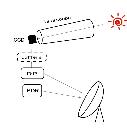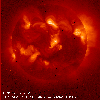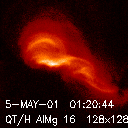 a schematic of data flow
a schematic of data flow
This week, after a long while, let us turn the spotlight backstage and look the instrumentation of the Yohkoh soft X-ray telescope, SXT. In this nugget we discuss how the SXT takes various kinds of images of the Sun and sends them to us on the ground. Special focus is put on the skillful "data buffering" system, which plays a vital role in producing a steady stream of different sorts data to be received by the ground-based operators.
To begin with, let us briefly review the flow of the soft X-ray information starting from the Sun right through the reception of the signals on the ground. As shown in the schematic below, the solar soft X-ray flux entering the telescope is focused on a CCD detector to give rise to a soft X-ray image. The image is then moved through a buffer - a storage unit for digital data - toward Yohkoh's central computer, the Data Processor (DP), where all data including those from other instruments and the status of the satellite itself are fitted into the format of the telemetry system, the satellite's transmission link to the ground. The resulting data are then stored in a data recorder until the satellite flies over the ground station and is allowed to "downlink." If the ground station is the Kagoshima station, real-time telemetry can also be transmitted without going through the recorder.
 a schematic of data flow
a schematic of data flow
As dedicated readers of the science nuggets may notice, our SXT is capable of yielding various kinds of images, with different size, exposure times, and spatial resolutions, and so on. Among these, the most fundamental distinctions may be the ones regarding the location and size of the observing area. The SXT has two modes with respect to the field-of-view (FOV): the Full Frame Image (FFI) mode, and the Partial Frame Image (PFI) mode. The former is usually used to take whole-sun images, and the latter to obtain images of a local region for which we can specify the location and the FOV size. The SXT normally alternates the two types, except during flare mode when it only does PFIs.
 an example of a Full Frame Image
an example of a Full Frame Image
 an example of a Partial Frame Image
an example of a Partial Frame Image
**** An example of the FFI sequence *****
date time TLM filters resol. exposure size
(msec)
0 5-MAY-01 01:14:40 QT/H Open /AlMg Half 5338.0 512x512
1 5-MAY-01 01:16:48 QT/H Open /AlMg Half 5338.0 512x512
2 5-MAY-01 01:18:56 QT/H Open /AlMg Half 5338.0 512x512
3 5-MAY-01 01:21:04 QT/H Open /AlMg Half 5338.0 512x512
4 5-MAY-01 01:23:12 QT/H Open /AlMg Half 38.0 512x512
5 5-MAY-01 01:25:20 QT/H Open /AlMg Half 5338.0 512x512
**** The concurrent PFI sequence *****
0 5-MAY-01 01:16:28 QT/H Open /AlMg Full 238.0 128x128
1 5-MAY-01 01:17:00 QT/H Open /Al12 Full 3778.0 128x128
2 5-MAY-01 01:17:32 QT/H Open /AlMg Full 468.0 128x128
3 5-MAY-01 01:18:04 QT/H Open /Al12 Full 7548.0 128x128
4 5-MAY-01 01:18:36 QT/H Open /AlMg Full 238.0 128x128
5 5-MAY-01 01:19:08 QT/H Open /Al12 Full 3778.0 128x128
6 5-MAY-01 01:19:40 QT/H Open /AlMg Full 468.0 128x128
7 5-MAY-01 01:20:12 QT/H Open /Al12 Full 7548.0 128x128
8 5-MAY-01 01:20:44 QT/H Open /AlMg Full 238.0 128x128
9 5-MAY-01 01:21:16 QT/H Open /Al12 Full 3778.0 128x128
10 5-MAY-01 01:21:48 QT/H Open /AlMg Full 468.0 128x128
11 5-MAY-01 01:22:20 QT/H Open /Al12 Full 7548.0 128x128
12 5-MAY-01 01:22:52 QT/H Open /AlMg Full 238.0 128x128
13 5-MAY-01 01:23:24 QT/H Open /Al12 Full 3778.0 128x128
14 5-MAY-01 01:23:56 QT/H Open /AlMg Full 468.0 128x128
15 5-MAY-01 01:24:28 QT/H Open /Al12 Full 7548.0 128x128
16 5-MAY-01 01:25:00 QT/H Open /AlMg Full 948.0 128x128
The trick of this continuous telemetry stream is in the buffer system on board Yohkoh. Although the CCD is single, the SXT has two buffers. Let's study a simple case, where we consider the data flow for only either FFI or PFI sequence. The first image is first stored in one buffer (buffer A) and then sent to the DP. While the data in the buffer A are being sent to the DP, the next image goes into the other buffer (buffer B). As soon as the transfer from buffer A is completed, the transfer from buffer B starts. At the same time, the next image is allowed to be taken, saved into buffer A, and waits there until all the data in buffer B have been completely sent out. By this "double-buffer" strategy the DP receives a steady flow of data and can match the format required by the telemetry stream. The cadence of images - the sampling schedule - is mainly determined by the speed of this transfer from the buffers to the DP, and thence to the telemetry.
 a schematic of the buffer system (for two successive steps)
a schematic of the buffer system (for two successive steps)
The real situation is, however, more complicated, because the SXT has FFI and PFI image formats and both have double buffers. What is the most confusing is that some parts of FFI and PFI buffers actually overlap in hardware, in order to save weight and size of the instrument. In spite of these tricks, the DP produces the continuous telemetry stream, which contains FFI, PFI, and other data at the fixed ratio (4:1:3 in the standard operating mode; see note1) at every moment. It looks like magic, but it's a combination of the simple principles described above and it has worked perfectly.
As seen above, an amazing performance of Yohkoh/SXT is supported by the clever management of the image buffers done by the DP. It's undoubtedly wonderful that the system still works properly and has kept providing us good images of the Sun for nearly 10 years. So let's cross our fingers so that our good fortune may continue!